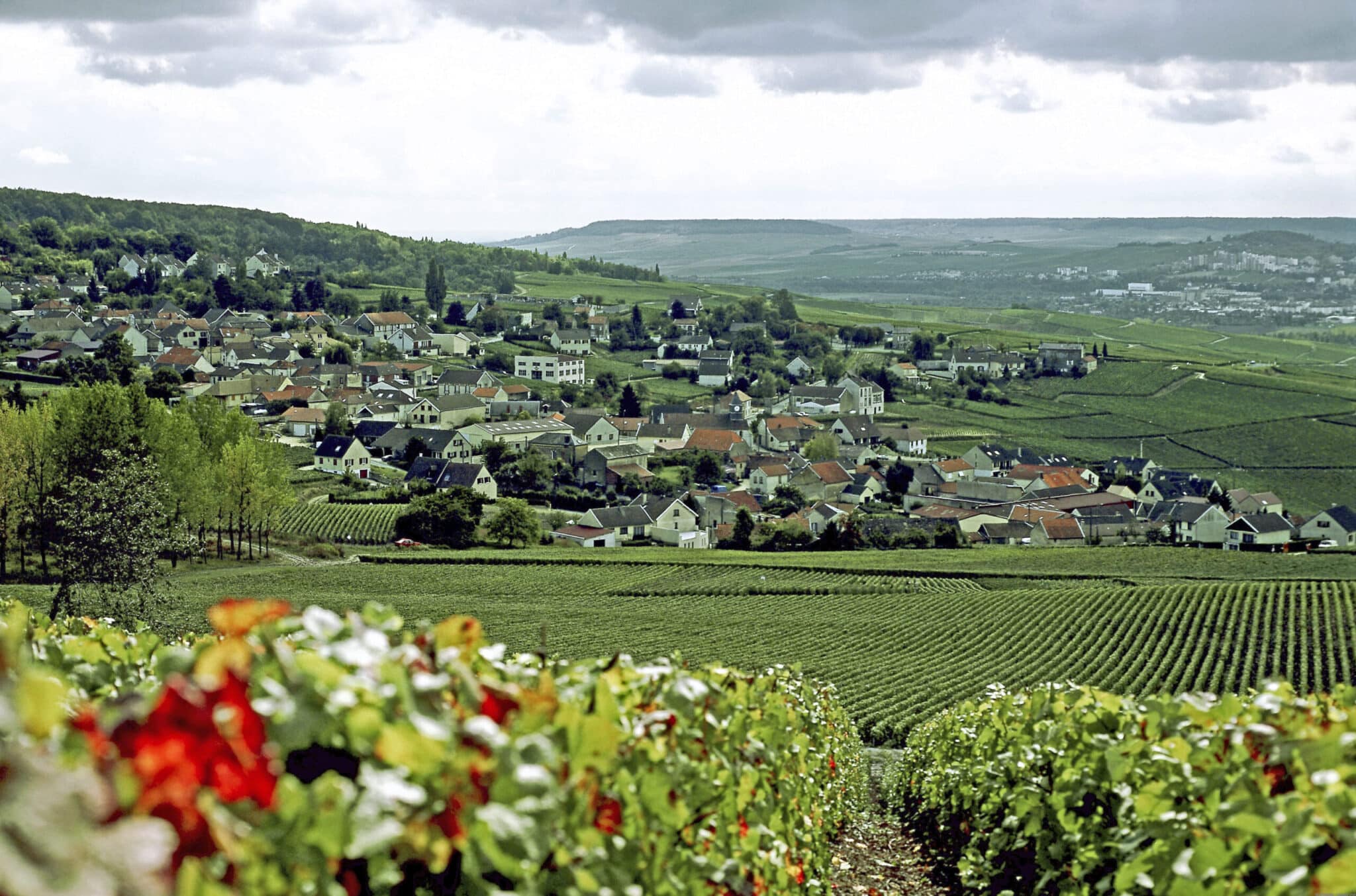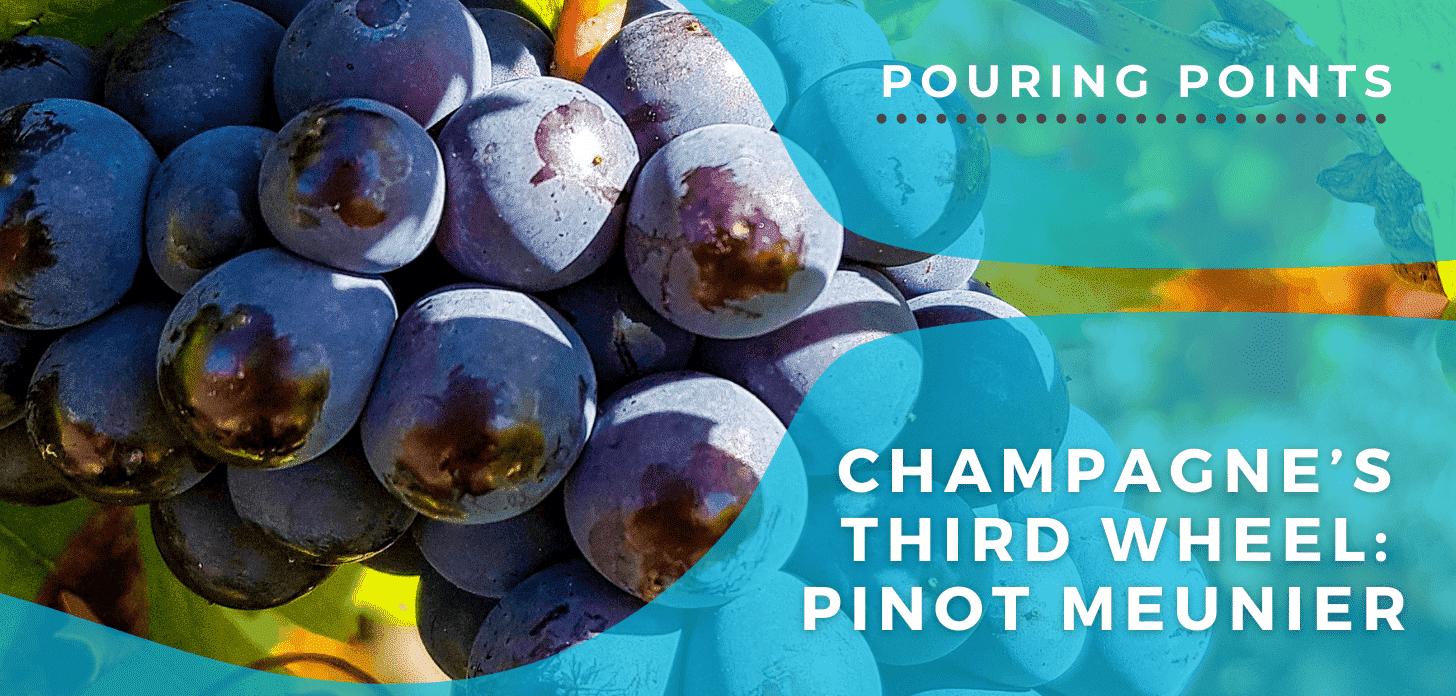By Nikki Goddard
Champagne, the world’s most prestigious sparkling wine, is typically made from some combination of three grapes—Chardonnay, Pinot Noir, and Pinot Meunier. While two of those varieties carry the same level of renown and nobility as the Champagne region itself, Pinot Meunier holds quite a different reputation.
Although recent numbers identify Meunier as France’s tenth most-planted black grape variety(1), its inclusion in a Champagne blend is rarely boasted about, and Pinot Meunier’s name is almost never displayed on a wine label.
Alongside its noble brethren, Meunier (as it’s known in Champagne) can be seen as pedestrian, criticized for its rusticity, simplicity, overt fruity character, and youthfully supple texture—fine for a supporting role, but lacking the sophistication and age-worthiness for the spotlight. In frequent comparisons to Pinot Noir, Meunier comes up short. But despite considerable lukewarm press, the humble grape certainly has its defenders, and thanks to a handful of dedicated producers, Meunier’s star has been on the rise in recent years.
It’s not a coincidence that Pinot Meunier shares so many attributes with the venerable Pinot Noir. The two varieties are close relatives; Pinot Meunier is, in fact, a mutation of Pinot Noir, just like Pinot Blanc and Pinot Gris, among others. The grape takes its name from the downy, powdery appearance of its leaves, which, because of the fine silver hairs that coat their undersides (and to a lesser degree, the upper sides), can seem as though they have been dusted with flour—”meunier” is French for “miller,” or “baker.”

Meunier’s ancestral homeland(2) is in Champagne, where almost all of its 28,000 total worldwide acres are grown today. Until recently, it was the most planted variety in the region, by a longshot, but today, just under one third of the vineyards there are planted to Meunier, while the remaining vines are split between Chardonnay (30%) and Pinot Noir (38%). Four other varieties—Arbane, Petit Meslier, Pinot Blanc, and Pinot Gris—are also permitted, but plantings are so scarce that they make up only about 0.3% of regional vines, combined.(3) Meunier is primarily grown in Champagne’s chilly, north-facing vineyards, particularly in the Marne Valley (Vallée de la Marne), where its cold-hardiness and disease resistance are valuable assets in the face of wet spring weather and cold winter frosts.
This is why Pinot Meunier endures: In the corners of Champagne where the venerable Chardonnay and Pinot Noir grapes struggle to ripen, the modest Meunier excels, making it indispensable to growers. But Meunier’s advantages go far beyond dependability. The variety contributes plenty of positive characteristics to both varietal and blended Champagne, in nearly all of its forms, from blanc de noirs to rosé to vintage and non-vintage cuvées, as well as the region’s rare and coveted non-sparkling Coteaux Champenois wines.
With higher acidity and more overt youthful fruit character and supple texture than Pinot Noir, Meunier makes a great counterpoint to the other major Champagne varieties. It softens the heft of Pinot Noir and rounds out the lean elegance of Chardonnay. While Pinot Meunier shares many of the typical aromas and flavors of its sibling Pinot Noir, as well as similarly restrained levels of tannin and alcohol, it has its own unique profile. The wines are lighter in color, featuring notes of tart cherry, pomegranate, raspberry, blueberry, rose petal, and spice, often alongside a somewhat rustic, sometimes smoky character, as well as accents of tangy, high-toned citrus. At times, Meunier can share some of Pinot Noir’s earthy, mushroomy qualities, but the focus tends to be on the ripe, rich fruit.(4) The best examples of Pinot Meunier tend to come from old vines, which lend complexity and concentration to the delicate variety.
Because Meunier matures faster than Pinot Noir and Chardonnay, it is frequently added to non-vintage blends to create a plush texture that makes them more accessible for early drinking. Critics of the variety believe that this faster evolution makes Meunier-based wines unsuitable for aging or inclusion in “serious” wines—and, considering how the grape is typically employed, this is often true. If a winemaker doesn’t believe in Meunier’s potential, and treats it accordingly as a “workhorse” or “filler” grape, it’s far less likely to impress.
But there are many distinguished Champagne houses that would emphatically disagree with the popular opinion of Meunier, and that have made strong arguments in its favor in the form of exceptional, age-worthy varietal and blended Champagnes that demand to be taken seriously. Among the most notable of these is Krug, where Meunier’s significant presence in the iconic house’s blended wines, including the flagship Brut Grande Cuvée, has long been proudly publicized.(5) Others have taken it a step further—in 2018, Gosset(6) became the first of the grandes marques to release a Champagne made entirely from Meunier, and Billecart-Salmon recently released(7) a one-off 100% Meunier, Le Rendez-Vous’ Pinot Meunier Extra Brut No. 1, to kick off a series of limited-edition experimental cuvées.
Meunier, however, tends to be more appreciated among small grower-producers—Laherte Frères makes a vintage-dated varietal extra brut bottling(8) called Les Vignes d’Autrefois from old vines planted between 1947 and 1953, Egly-Ouriet produces an all-Meunier premier cru blanc de noirs, Les Vignes de Vrigny, from grapes grown on the chalky soils of Montagne de Reims,(9) and Jérôme Prévost uses the grape almost exclusively for his minuscule-production, cult classic Champagnes. Excellent Meunier-based Champagnes can also be found at Chartogne-Taillet, Christophe Mignon, Dehours et Fils, Benoît Déhu, Flavien Nowack, Chevreux-Bournazel, Tarlant, Bérèche et Fils, and others. In 2015, led by Éric Taillet, a group of small grower-producers in Champagne came together to form the Meunier Institut,(10) in hopes of clearing up misconceptions about the grape and improving its reputation.
Indeed, things are looking up for Meunier—as Champagne houses of all sizes and styles continue to embrace the variety, and these new and unusual cuvées pique the interests of retailers and sommeliers, consumers will become increasingly open-minded. In this new era for Champagne’s most misunderstood grape, Meunier’s distinctive character just might become a selling point, rather than a disadvantage.
References
(1) https://www.jancisrobinson.com/ocw/detail/pinot-meunier
(2) TK Wine Grapes
(3) https://www.champagne.fr/en/from-vine-to-wine/grape-varieties-vineyards/grape-varieties
(4) https://thatusefulwinesite.com/varietals/reds/PinotMeunier.php and https://www.wine-searcher.com/grape-383-pinot-meunier
(6) https://www.therealreview.com/2015/07/29/new-tasting-notes-syrahviognier-falling-out-of-fashion/
(9) https://www.meunierinstitut.fr/nos-ambassadeursmeunier?lang=en














